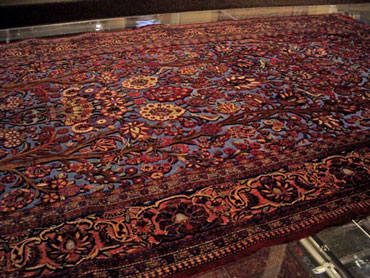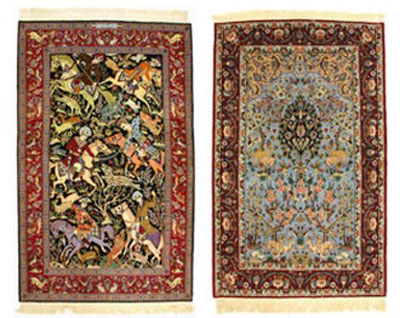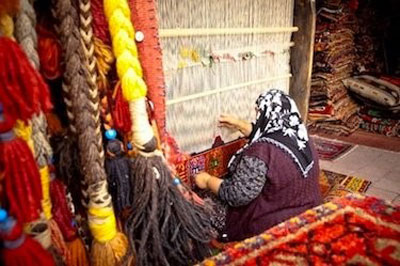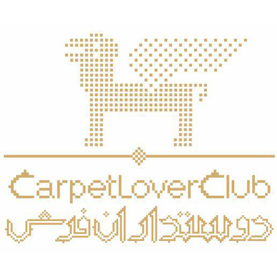10 determining factors of handmade carpet price

There are many reasons and different factors which sets the price, here will be explained these factors in more detail. From the basic price, the artistic quality is judged and the handicraft is compared to similar carpets in the same style to set the final price. Consider the following factors when pricing a rug:
Age
- New:The NEW rugs usually have been made in the last 0-5 years period.
- Old:The Old rugs usually have been made in the last 5-25 years period.
- Semi-Antique:The Semi Antique rugs usually have been made in the last 25-60 years period.
- Antique:The Antique rugs usually have been made in the last 60-250 years period.
In general expect to pay more for antique rugs than older average rugs. Some new rugs also command high prices.
Size
A larger carpet takes more time to weave which also makes it more expensive.
- Zaronim5′ x 3′(150 x 90 cm)
- Dozar6′ 6″ x 4′ 6″(200 x 135 cm)
- Zarcharak4′ 3″ x 2′ 9″(130 x 80 cm)
Since most Persian Rugs are made using metric system (i.e. 2×3 meter), expect to pay higher prices for rare sizes such as square or round rugs.
Material
All silk rugs are the most expensive, next are rugs with silk foundation and wool with silk highlight pile.
Color
Rugs with natural colors are more expensive than synthetic dyed rugs. Although today majority of rug producer use synthetic dyes.
Knots
There is big debate about knots as indication of price. Perofesionals are believe knots is exteremly key factor to define the price The number of the knots in the back of the rugs:
Style & origin
There are great differences when it comes to the handicraft and the quality of the material in a Persian carpet compared to a carpet from India. As well as the conditions between a workshop manufactured carpet and a carpet made by nomads.
Layout & pattern
If the carpet has an all-over motif or just fewer and smaller motifs this also affects the price. If it has a more detailed pattern, which took a long time to weave, then this will result in a higher price.
Condition
If the carpet is in good condition without damages it is of course more expensive than a worn out, frayed carpet with bleached colours. The comparison between new and older production is twisted by the fact that from the old production it is only the best carpets that are preserved. Spot, Odor, wear, low pile are conditions that affect price of handmade rug.
The artistic expression

An Isfahan carpet is more expensive than the other. Two carpets with the same technical quality, here it is the artistic expression that sets the price. Two carpets made at the same time in the same village by the same work team can differ enormously in price. Why? Despite that the same number of knots have been used, the same material and that the carpets are exactly the same size, one is much more expensive. One big reason for this can be for example the combination of the colours and the pattern used in the carpet. Another major reason may be the way they chose to weave the carpet – did they use “a thick pen” when drawing the pattern and therefore the fine but very important details had to be dropped? With a more detailed pattern, one gets a much more beautiful carpet even if the number of knots are the same!
Comparison

Always compare carpets of the same style, here a Tabriz and an Isfahan . A comparison between the two of them doesn’t say much about any of the carpets. If one should compare a handmade oriental carpet to another it is of great importance that it is compared to one in the same style, meaning a Tabriz with a Tabriz and not with an Isfahan for example. You will find that different techniques, way of weaving and different types of yarn are used, just to give a few examples. One should not compare workshop manufactured carpets with nomad carpets. Different work conditions gives a different price.
determining antique carpet price
There is, of course, a great deal that goes into determination the price or value of an antique rug. It goes without saying that the same is true of any work of art. On the most basic level, the cost or value of an is determined by what someone / the market is willing to pay for it. The value of a rug will depend on how much dealers are willing to pay to acquire it. The price that the dealers set when they want to sell the carpet will depend on the size, rarity, quality of wool, weave, color, condition, age, design and especially how all these attributes combine together in the piece. Generally speaking, age does play a significant factor when it comes to valuating the worth of a rug. But its necessarily the actual age that impacts the value but the older the rugs, especially those from the late 19th century and those from the 15th-17th centuries. These older rugs focused on quality and not affordability. This is why many of the older rugs were woven using better base materials and far more attention was paid when each carpet was produced. Older rugs, especially those that are in good condition, are also more valued because they are rarer and have a look and feel like nothing that could be produced today. While not always the case, especially when dealing with rare and collectible piece, larger rugs will generally cost more than small ones. To a certain extent, values are based intrinsic factors that do not reflect changes in taste. That said, trends will affect the prices or value as demand certain looks grows and supply of these one-of-a-kind items will, over time, diminish. At any given time certain types of rugs will be more popular than others. Naturally, this sort of demand will create a higher price base (at least for a certain period of time). But trends change and fads fade. Therefore the value of “trendy” items has a greater risk of diminishing once the trends change. Collectible, rare and the “best” examples do tends to retain their value over time. These “cream of the crop” pieces have also been the safest investments and they have a strong track record of escalating in value over time.
how to recognize handmade and machine weaven carpets : one of determining factors of price

It is not a simple task for normal folks not trained in identifying rugs to know the distinction between an authentic handmade rug and a machine-made rug. Handwoven are mostly collectibles due to their quality. The quality of rugs hugely depends on the yarns’ quality, dyes used and knot count among other factors. You will find rugs knotted by hand are made through a loom specially designed and knotted through the use of the hand. Hand knotted oriental rugs have been made for centuries through an ancient art that can only be admired. The loom’s size depends on the rug’s size with the weaving carried out moving from the bottom going up to the top. The weaver of the rug usually interweaves the “knots” into the rug’s groundwork, which are hand tied, something that makes the rug’s pile. It is a very time consuming and a tedious operation.
Changes in rug color

It is also easy to note some slight changes in color that make thin or thick stripes when it comes to a handmade rug. Such is the result of dyes used to change the wool during weaving or just the way the wool’s colors age due to the atmosphere, light, and washing. Most of the color changes can be seen in the rug’s background color known as abrash. It is hard to find such circumstances in rugs made by machines.
Wool pile and warp
It is worth noting handmade rugs in most cases have wool pile used to weave them. A rug made by a machine is mostly made through the use of a polyester or nylon pile while weaving is very uniform and close. Also for any authentic rug, on the rug’s back, you will find white thread weaves from one end of the fringe to the other called the warp.
Visual rug differences

There is always a very strong difference between a handmade and machine-made rug visually. This is apparent especially on the back of a machine-made rug which is very distinct in terms of APPEARANCE TO A HANDMADE RUG’s back. You will find the design of the machine-made rug’s back not as colorful as the back of the hand-woven Oriental rug. While the machine-made rug has its edges machine overstitched and a fringe applied, the handmade Oriental rug’s fringe runs throughout the length of the rug which is called the warp. The machine-made rug has overstitch patterns running across its back and distinguishing individual knots appearing on the back are not easy to find. In fact, for the machine-made rug, the overstitch construction is generally what keeps the pile material held together. This means that the fringe is applied on a machine-made rug once it has been completed while the hand-woven rug has its fringe as a part of warp strings as they leave the handmade rug’s end. You can turn towards the front part of the rug and peruse the designs intently. Essentially, the design should never be of the same shape and size from one opposite end to the other end of the potentially handmade rug. Also, the design patterns will not always be perfect either. This unevenness is something that is clear in most handmadel rugs that are much older and is a sign of authenticity and should not be mistaken for a poorly done rug. Machine-made rugs usually contain same pattern sizes all around and variations are not really visible. However, machine-made imitations do have uneven patterns but this is less common.







